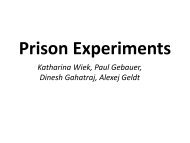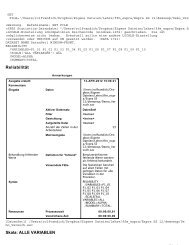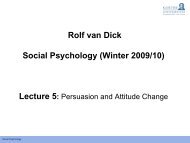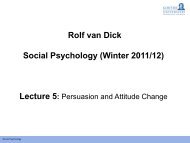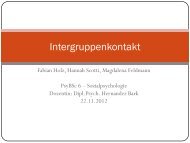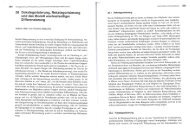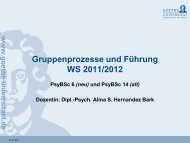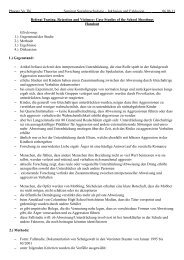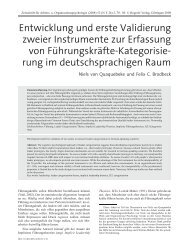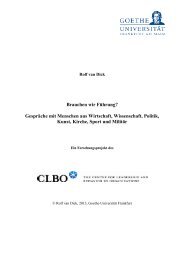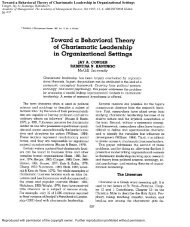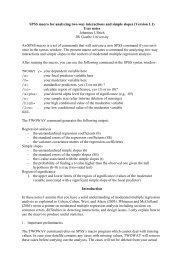Bulletin Personality and Social Psychology - Sozialpsychologie
Bulletin Personality and Social Psychology - Sozialpsychologie
Bulletin Personality and Social Psychology - Sozialpsychologie
Create successful ePaper yourself
Turn your PDF publications into a flip-book with our unique Google optimized e-Paper software.
<strong>Personality</strong> <strong>and</strong> <strong>Social</strong> <strong>Psychology</strong><br />
<strong>Bulletin</strong><br />
http://psp.sagepub.com/<br />
Revisiting the Stanford Prison Experiment: Could Participant Self-Selection Have Led to the Cruelty?<br />
Thomas Carnahan <strong>and</strong> Sam McFarl<strong>and</strong><br />
Pers Soc Psychol Bull 2007 33: 603 originally published online 17 April 2007<br />
DOI: 10.1177/0146167206292689<br />
The online version of this article can be found at:<br />
http://psp.sagepub.com/content/33/5/603<br />
Published by:<br />
http://www.sagepublications.com<br />
On behalf of:<br />
Society for <strong>Personality</strong> <strong>and</strong> <strong>Social</strong> <strong>Psychology</strong><br />
Additional services <strong>and</strong> information for <strong>Personality</strong> <strong>and</strong> <strong>Social</strong> <strong>Psychology</strong> <strong>Bulletin</strong> can be found at:<br />
Email Alerts: http://psp.sagepub.com/cgi/alerts<br />
Subscriptions: http://psp.sagepub.com/subscriptions<br />
Reprints: http://www.sagepub.com/journalsReprints.nav<br />
Permissions: http://www.sagepub.com/journalsPermissions.nav<br />
Citations: http://psp.sagepub.com/content/33/5/603.refs.html<br />
Downloaded from psp.sagepub.com at Universitaetsbibliothek on September 13, 2011
Revisiting the Stanford Prison Experiment:<br />
Could Participant Self-Selection Have<br />
Led to the Cruelty?<br />
Thomas Carnahan<br />
Sam McFarl<strong>and</strong><br />
Western Kentucky University<br />
The authors investigated whether students who selectively<br />
volunteer for a study of prison life possess dispositions<br />
associated with behaving abusively. Students were<br />
recruited for a psychological study of prison life using a<br />
virtually identical newspaper ad as used in the Stanford<br />
Prison Experiment (SPE; Haney, Banks & Zimbardo,<br />
1973) or for a psychological study, an identical ad minus<br />
the words of prison life. Volunteers for the prison study<br />
scored significantly higher on measures of the abuserelated<br />
dispositions of aggressiveness, authoritarianism,<br />
Machiavellianism, narcissism, <strong>and</strong> social dominance <strong>and</strong><br />
lower on empathy <strong>and</strong> altruism, two qualities inversely<br />
related to aggressive abuse. Although implications for<br />
the SPE remain a matter of conjecture, an interpretation<br />
in terms of person-situation interactionism rather<br />
than a strict situationist account is indicated by these<br />
findings. Implications for interpreting the abusiveness of<br />
American military guards at Abu Ghraib Prison also are<br />
discussed.<br />
Keywords:<br />
prison; aggression; Machiavellianism; authoritarianism;<br />
narcissism<br />
The Stanford Prison Experiment (Haney, Banks &<br />
Zimbardo, 1973), one of psychology’s best known studies,<br />
is often cited in textbooks as showing that powerful<br />
social situations can induce normal young men to<br />
behave inhumanely (e.g., Myers, 2002). To Zimbardo,<br />
The value of the Stanford Prison Experiment (SPE)<br />
resided in demonstrating the evil that good people can be<br />
readily induced into doing to other good people within<br />
the context of socially approved roles, rules, <strong>and</strong> norms,<br />
a legitimizing ideology, <strong>and</strong> institutional support.<br />
(Zimbardo, Maslach, & Haney, 2000, p. 194)<br />
This situationist interpretation of the SPE’s results, that<br />
the power of the situation overwhelms the moral<br />
restraints of good people, has rarely been questioned.<br />
However, in his analysis of 20th-century genocides <strong>and</strong><br />
mass killings, Staub (1989) reported that young men with<br />
cruelty-related dispositions often self-select to join groups<br />
such as the Nazi SS. He then suggested that “self-selection<br />
may have played a role in the prison study I discussed earlier<br />
[i.e., the SPE] . . . the personal characteristics of<br />
those who answered the advertisements may have been<br />
one reason for the intensifying hostility” (p. 70). In the<br />
study reported here, we investigated whether students<br />
who volunteer for such a study today may possess dispositions<br />
associated with acting abusively. Of course, we<br />
cannot revisit the SPE <strong>and</strong> determine whether <strong>and</strong> how<br />
selective volunteering may have contributed to its results.<br />
How results from a current study apply to the SPE can<br />
Authors’ Note: Thomas Carnahan is now at The Personnel Board of<br />
Jefferson County, Birmingham, Alabama. This article is based on the<br />
master’s thesis of the first author directed by the second. The study<br />
was supported by a Western Kentucky University graduate research<br />
grant to the first author. We sincerely thank all reviewers <strong>and</strong> the editor<br />
for their helpful comments on earlier drafts of this article.<br />
Correspondence concerning this article should be addressed to Sam<br />
McFarl<strong>and</strong>, Department of <strong>Psychology</strong>, 1906 College Heights Blvd.,<br />
Western Kentucky University, Bowling Green, KY 42101-1030; e-<br />
mail: sam.mcfarl<strong>and</strong>@wku.edu.<br />
PSPB, Vol. 33 No. 5, May 2007 603-614<br />
DOI: 10.1177/0146167206292689<br />
© 2007 by the Society for <strong>Personality</strong> <strong>and</strong> <strong>Social</strong> <strong>Psychology</strong>, Inc.<br />
603<br />
Downloaded from psp.sagepub.com at Universitaetsbibliothek on September 13, 2011
604 PERSONALITY AND SOCIAL PSYCHOLOGY BULLETIN<br />
only be inferred. But if those who volunteer for a study of<br />
prison life possess such dispositions, if placed in a prison<br />
experiment or setting, they also might mutually disinhibit<br />
<strong>and</strong> reinforce one another’s readiness to act abusively.<br />
The specifics of the SPE are well known. Male college<br />
students responded to a newspaper ad to take part in “a<br />
psychological study of prison life,” to be paid $15 a day<br />
for a study to last for 1 to 2 weeks. The advertisement<br />
instructed interested students to go to Jordan Hall on<br />
Stanford University’s campus for further information <strong>and</strong><br />
applications. The 75 who responded were interviewed<br />
concerning their mental health history, family history of<br />
psychopathology, <strong>and</strong> past antisocial behaviors. The 24<br />
“judged to be the most stable (physically <strong>and</strong> mentally),<br />
most mature, <strong>and</strong> least involved in antisocial behavior”<br />
(Haney et al., 1973, p. 73) were selected <strong>and</strong> assigned<br />
r<strong>and</strong>omly to the roles of prisoners or guards. Both the<br />
mundane <strong>and</strong> experimental realism of the simulated<br />
prison were compelling, but an intended 2-week study<br />
was terminated after 6 days “because too many normal<br />
young men were behaving pathologically as powerless<br />
prisoners or as sadistic, all-powerful guards” (Zimbardo<br />
et al., 2000, p. 202). Details of the study are available in<br />
several reports (Haney et al., 1973; Haney & Zimbardo,<br />
1998; Zimbardo, 1975, 1995; Zimbardo et al., 2000). A<br />
video of the experiment (Zimbardo, 1989) <strong>and</strong> Web site<br />
(http://www.prisonexp.org/) also are available (see also<br />
Reicher & Haslam, 2006).<br />
When the SPE was conducted in 1971, the situation<br />
versus personal disposition debate loomed large. To its<br />
authors, the SPE results required a situationist rather<br />
than a dispositional explanation (Haney et al., 1973).<br />
Because prisoners <strong>and</strong> guards were assigned r<strong>and</strong>omly to<br />
their roles, <strong>and</strong> because personality measures did not predict<br />
behavior in either role (with the exception that five<br />
prisoners granted early release due to extreme emotional<br />
distress were quite low in authoritarianism), certainly the<br />
power of the situation must explain the guards’ cruelty<br />
<strong>and</strong> the prisoners’ passivity <strong>and</strong> depression.<br />
Two lessons Zimbardo <strong>and</strong> colleagues drew from<br />
this study were,<br />
Good people can be induced, seduced, initiated into<br />
behaving in evil (irrational, stupid, self-destructive, antisocial)<br />
ways by immersion in “total situations” that can<br />
transform human nature in ways that challenge our<br />
sense of the stability <strong>and</strong> consistency of individual personality,<br />
character, <strong>and</strong> morality . . . [<strong>and</strong>] . . . Human<br />
nature can be transformed within certain powerful<br />
social settings in ways as dramatic as the chemical<br />
transformation in the captivating fable of Dr. Jekyll <strong>and</strong><br />
Mr. Hyde. (Zimbardo et al., 2000, p. 206)<br />
This situationist interpretation has seemed compelling<br />
to many observers.<br />
The view that those who commit such horrors are<br />
essentially normal young men impelled by powerful situational<br />
pressures is consistent with Browning’s (1992) view<br />
of Nazi perpetrators as “ordinary men” under intense<br />
pressure, Haritos-Fatouros’s (1988) analysis of the conditioning<br />
of Greek torturers, <strong>and</strong> Huggins, Haritos-<br />
Fatouros, <strong>and</strong> Zimbardo’s (2002) study of Brazilian police<br />
torturers <strong>and</strong> murderers, for whom they found no prior<br />
evidence of either sadism or mental disorder.<br />
But since the 1970s, the principle of interactionism,<br />
that behavior is a product of the interaction of the<br />
person <strong>and</strong> the situation, has become well-established in<br />
social psychology (e.g., Blass, 1991). One general rule is<br />
that personal dispositions exert less influence on behavior<br />
for those in “strong” situations, situations that place<br />
powerful constraints on behavior (e.g., Aries, Gold, &<br />
Weigel, 1983; Kenrick & Funder, 1988). Clearly, the<br />
SPE presented a very strong situation. Still, the influence<br />
of individual differences rarely, if ever, fully evaporates.<br />
Even in such strong experimental situations as<br />
Milgram’s (1963) classic destructive obedience study<br />
<strong>and</strong> in real-life strong situations such as the My Lai massacre<br />
during the Vietnam war, some individuals did not<br />
obey the dem<strong>and</strong>s of the controlling authority despite<br />
intense pressure to do so (Blass, 1991; Lifton, 1973).<br />
It is also now a well-established interactionist principle<br />
that individuals respond to situations proactively as well<br />
as reactively by choosing to place themselves in some situations<br />
<strong>and</strong> to avoid others (Blass, 1991; Ickes, Snyder,<br />
& Garcia, 1997). Emmons, Diener, <strong>and</strong> Larsen (1986)<br />
found that “in their everyday environment, individuals<br />
do choose to spend time in certain situations <strong>and</strong> avoid<br />
others <strong>and</strong> that these patterns of choice <strong>and</strong> avoidance<br />
are predictable from personality trait scores” (p. 815).<br />
Selectively volunteering for a group study makes relevant<br />
a third aspect of interactionism, one reflected in<br />
the phenomenon of group polarization (e.g., Myers &<br />
Lamm, 1976). The members who comprise a group<br />
constitute a critical part of the situation. Those who<br />
self-select for any situation are likely attuned to its permitted<br />
behaviors <strong>and</strong> requirements, <strong>and</strong> they often reinforce<br />
one another in the direction of their common<br />
inclinations. One study found that burglars report<br />
engaging in more burglary when together in groups<br />
(Cromwell, Marks, Olson, & Avary, 1991). In the case<br />
of the SPE, if the individuals who volunteered possessed<br />
traits associated with abusiveness, they could well have<br />
reinforced one another in that direction. If individuals<br />
not so prone were placed in the SPE, they might not<br />
have spawned the same abuse.<br />
The current study addresses the self-selection component<br />
of interactionism. Congruent with this principle, a<br />
number of studies have shown that individuals selectively<br />
volunteer for psychological studies that appear to<br />
Downloaded from psp.sagepub.com at Universitaetsbibliothek on September 13, 2011
Carnahan, McFarl<strong>and</strong> / SELF-SELECTION AND PRISON LIFE 605<br />
fit their personalities. Dollinger <strong>and</strong> Leong (1993) found<br />
that the Big Five personality factors of Agreeableness<br />
<strong>and</strong> Openness to Experience predicted a willingness to<br />
participate in a longitudinal study where one’s test <strong>and</strong><br />
personality scores would be known. Students high in<br />
conservatism have been found less prone to volunteer<br />
for studies that appear to require openness to experience<br />
(Joe, Jones, & Ryder, 1977). Dispositional sympathy<br />
has predicted volunteering for studies of helping<br />
people in distress (Smith, 1992). Individuals high in sensation<br />
seeking have volunteered more than others for<br />
studies rated as exciting but not for studies rated as<br />
unexciting (Thomas, 1989). In a time of personal need<br />
(i.e., just before midterm exams), individuals high in<br />
just world beliefs were found more likely to volunteer<br />
for a psychological study, but not at other times, as if<br />
volunteering before exams would be repaid by success<br />
on exams (Zuckerman, 1975). Need for achievement<br />
has predicted men’s volunteering for a study of group<br />
performance (Coye, 1985). Greater sexual experience<br />
for both genders <strong>and</strong> erotophilia for women have predicted<br />
volunteering for a study of erotica (Saunders,<br />
Fisher, Hewitt, & Clayton, 1985). Codependent female<br />
students (i.e., daughters of alcoholic parents) were<br />
found more likely to volunteer to help an experimenter<br />
described as exploitive than one described as nurturant,<br />
whereas noncodependent females did the opposite<br />
(Lyon & Greenberg, 1991).<br />
Volunteering outside the laboratory also is affected by<br />
the volunteers’ personalities: Davis et al. (1999) found<br />
that students high in dispositional empathy were particularly<br />
likely to volunteer for a community agency where<br />
they would meet needy persons. Individuals high in selfmonitoring<br />
have been found particularly likely to do volunteer<br />
work when there are social rewards for doing it<br />
(White & Gerstein, 1987). Hobfoll (1980) found that participants<br />
who volunteered to tutor inner-city preschool<br />
children without monetary incentives were higher than<br />
nonvolunteers on a measure of social responsibility.<br />
Given these findings, it seemed to us very likely that<br />
men who choose to volunteer for a study advertised as<br />
a “psychological study of prison life” may well be<br />
drawn to it because of a fit to their particular personalities.<br />
Indeed, it is hard for us to imagine otherwise, particularly<br />
so because the study is advertised as lasting<br />
more than a week <strong>and</strong> would likely place participants in<br />
an unusual <strong>and</strong> intense situation. Also, if the traits that<br />
draw them to the study are also those associated with<br />
abusive behavior, the abuse in a prison simulation may<br />
be due to the combination of the personal qualities of<br />
the volunteers with the force of the situation, including<br />
the mutual reinforcement of other volunteers, rather<br />
than to the power of the situation alone. Money ($15<br />
per day in the SPE, equivalent with inflation to $70 per<br />
day in 2004) is certainly an important inducement for<br />
students to volunteer. Nevertheless, those reading the<br />
ad must still decide to pursue or not pursue this opportunity,<br />
<strong>and</strong> here we think it likely that personal dispositions<br />
might well lead some to choose <strong>and</strong> others to<br />
avoid a study of prison life. We find it surprising that<br />
now, more than 30 years after the SPE, a study of this<br />
issue has not been reported.<br />
We examined, then, whether male students who<br />
respond to an ad as used in the SPE differ from those<br />
recruited with the same ad that excluded the phrase “of<br />
prison life.” Although many traits might influence volunteering<br />
for a study of prison life, we were particularly<br />
interested in traits that might both induce volunteering<br />
<strong>and</strong> are associated with abusiveness. If those who volunteer<br />
for the prison life study differ on such traits as<br />
expected, the strict situationist view that good <strong>and</strong> normal<br />
young men can be induced easily to abusive behavior<br />
by the power of the social situation is weakened.<br />
Instead, the process of self-selection may result in participants<br />
who are psychologically ready to be so<br />
induced. Then, if several within the group share these<br />
tendencies, they may well intensify each other’s readiness<br />
to act abusively.<br />
We focused on qualities associated with the guards’<br />
abusiveness rather than the prisoners’ pathological passivity<br />
<strong>and</strong> depression for several reasons. As a matter of<br />
practical interest, the SPE is used most often to explain<br />
the power of the situation to induce cruelty, as is illustrated<br />
by its recent use to explain the abusiveness of<br />
American guards at Abu Ghraib (e.g., Cookson, 2004;<br />
Fiske, Harris, & Cuddy, 2004; Zimbardo, 2004).<br />
Second, qualities associated with abuse <strong>and</strong> aggression<br />
seemed likely to be those that encourage volunteering.<br />
These qualities are stereotypical of both prisoners <strong>and</strong><br />
guards, a point addressed later in this article, <strong>and</strong><br />
stereotypically important for both roles. Guards need to<br />
be threatening <strong>and</strong> controlling, but so do prisoners if<br />
they are to survive <strong>and</strong> prosper in the meanness of the<br />
prison yard, where dominance <strong>and</strong> manipulation offer<br />
power <strong>and</strong> where the weak <strong>and</strong> timid are most vulnerable.<br />
Those who possess these qualities might then volunteer<br />
regardless of whether they thought they would<br />
become prisoners or guards. Finally, in the SPE, participants<br />
did not accurately anticipate the situation of the<br />
prisoners, who “exhibited disbelief at the total invasion<br />
of their privacy, constant surveillance <strong>and</strong> atmosphere<br />
of oppression in which they were living” (Haney et al.,<br />
1973, p. 95). Given that misanticipation, personal qualities<br />
associated with passivity <strong>and</strong> depression seemed<br />
unlikely to induce volunteering.<br />
What personality traits seem likely to both promote<br />
volunteering for a “study of prison life” <strong>and</strong> a readiness<br />
for abusive behavior? Casting a somewhat broad net,<br />
Downloaded from psp.sagepub.com at Universitaetsbibliothek on September 13, 2011
606 PERSONALITY AND SOCIAL PSYCHOLOGY BULLETIN<br />
seven were chosen for this study. Volunteering appeared<br />
likely to be positively related to the following five qualities:<br />
Aggression. Dispositional aggression, as defined by<br />
Buss <strong>and</strong> Perry (1992), includes general hostility, propensity<br />
toward anger, <strong>and</strong> tendencies toward both physical<br />
<strong>and</strong> verbal aggression. Their self-report Aggression<br />
Questionnaire correlated positively with peer ratings of<br />
all these qualities. Because such dispositions <strong>and</strong> behaviors<br />
are common in prisons, dispositional aggression<br />
seems likely both to induce volunteering for such a<br />
study <strong>and</strong> to be associated with aggressiveness in a<br />
prison simulation.<br />
Right-Wing Authoritarianism (RWA). In Altemeyer’s<br />
(1996) work on right-wing authoritarianism, two of its<br />
three defining qualities are authoritarian submission (“a<br />
high degree of submission to authorities,” p. 6) <strong>and</strong><br />
authoritarian aggression (“intentionally causing harm to<br />
someone,” p. 8), particularly when such aggression is<br />
socially sanctioned. Because prison life includes both<br />
submission <strong>and</strong> aggression, individuals high in authoritarianism<br />
should be drawn to such a study <strong>and</strong> particularly<br />
ready to engage in sanctioned aggression once<br />
there. In social psychology’s other paradigm showing<br />
harmful behavior by normal men, the Milgram (1963)<br />
obedience paradigm, Elms <strong>and</strong> Milgram (1966) found<br />
that 40 men who had administered all the shocks were<br />
significantly higher on the original authoritarianism<br />
F-scale (Adorno, Frenkel-Brunswik, Levinson, &<br />
Sanford, 1950) than were 40 men who had not. Because<br />
all F-scale items are worded in a protrait direction,<br />
Altemeyer (1981) developed the balanced RWA scale<br />
<strong>and</strong> showed in several studies its validity advantages<br />
over the F-scale. In a study similar to the Milgram paradigm,<br />
Altemeyer allowed participants to choose among<br />
five levels of shock to administer to learners for mistakes<br />
on a fake learning experiment. Scores on the RWA correlated<br />
positively with the severity of the shocks selected.<br />
Machiavellianism. Machiavellianism as a personality<br />
trait refers to the tendencies to mistrust others, manipulate<br />
<strong>and</strong> lie to them, treat them as tools for achieving<br />
one’s own ends, <strong>and</strong> act without compunction about<br />
injuring them (Christie & Geis, 1970). McHoskey,<br />
Worzel, <strong>and</strong> Szyarto (1998) showed that the Mach-IV<br />
measure of Machiavellianism “is a global measure of<br />
psychopathy in noninstitutionalized populations” (p.<br />
192). McHoskey et al. characterized Machiavellians as<br />
successful psychopaths because they are not imprisoned<br />
with felon convictions. Because Machiavellian/psychopathic<br />
behavior abounds in prisons, individuals high in<br />
Machiavellianism appear to be particularly likely to be<br />
drawn to a study of prison life <strong>and</strong>, once there, this<br />
Machiavellianism would be associated with these<br />
Machiavellian behaviors.<br />
Narcissism. The qualities Raskin <strong>and</strong> Hall (1979)<br />
used to identify the narcissistic personality, drawn from<br />
the Diagnostic <strong>and</strong> Statistical Manual–III, included<br />
“preoccupation with fantasies of unlimited . . . power . . .<br />
characteristic responses to threats to self-esteem (anger,<br />
hostility, rage), . . . interpersonal exploitativeness, . . .<br />
<strong>and</strong> lack of empathy” (p. 590). These qualities, similar<br />
to those of Machiavellianism, seemed likely to draw<br />
individuals to a study of prison life <strong>and</strong> to be associated<br />
with abusiveness once there. A number of studies have<br />
found that narcissism predicts aggression, especially in<br />
situations where one’s ego is threatened (e.g., Bushman<br />
& Baumeister, 2002; Washburn, McMahon, King,<br />
Reinecke, & Silver, 2004).<br />
<strong>Social</strong> dominance orientation. <strong>Social</strong> dominance is<br />
defined as “the degree to which individuals desire <strong>and</strong><br />
support group-based hierarchy <strong>and</strong> the domination of<br />
‘inferior’ groups by ‘superior’ groups” (Sidanius & Pratto,<br />
1999, p. 48). Individuals high in social dominance may be<br />
drawn to volunteer for the prison study due to the explicit<br />
hierarchical structure of the prison system, <strong>and</strong> such individuals<br />
are unconcerned about the human costs of their<br />
actions. McFarl<strong>and</strong> (2005) recently found that social<br />
dominance predicted support for launching the attack on<br />
Iraq <strong>and</strong> that this support was mediated by a lack of concern<br />
for the human costs of the war.<br />
In contrast, the following two traits seemed likely to<br />
reduce volunteering for a study of prison life:<br />
Dispositional empathy. A recent meta-analysis found<br />
an inverse relationship between empathy <strong>and</strong> being a<br />
violent offender (Jolliffe, 2004). As measured by Davis’s<br />
(1983) Interpersonal Reactivity Index (IRI), dispositional<br />
empathy includes both feelings of sympathy <strong>and</strong><br />
a tendency to consider the perspective of others in disputes<br />
<strong>and</strong> disagreements. Because these are not stereotypical<br />
qualities of either prison guards or prisoners,<br />
possessing these qualities seems likely to reduce volunteering<br />
for the study of prison life, whereas those low in<br />
dispositional empathy might be more likely to volunteer.<br />
In turn, behaving cruelly in the prison simulation<br />
should be associated with being low in empathy because<br />
those low in empathy possess fewer feelings of compassion<br />
<strong>and</strong> less inclination to consider their abuse from<br />
the perspective of their victims.<br />
Altruism. Altruism consists of unselfish, prosocial<br />
behaviors that benefit others. In their longitudinal study<br />
of the development of aggression, Eron <strong>and</strong> Huessmann<br />
(1984) found that altruistic behavior <strong>and</strong> aggression<br />
Downloaded from psp.sagepub.com at Universitaetsbibliothek on September 13, 2011
Carnahan, McFarl<strong>and</strong> / SELF-SELECTION AND PRISON LIFE 607<br />
“were consistently negatively related to each other . . .<br />
both synchronously <strong>and</strong> over time . . . [<strong>and</strong> that] . . .<br />
prosocial behavior <strong>and</strong> aggression represent opposite<br />
ends of a single dimension of behavior” (p. 201). Because<br />
aggression rather than altruism abounds in prisons, individuals<br />
high on altruism should be unlikely to volunteer.<br />
In short, we hypothesized that those who would volunteer<br />
for “a psychological study of prison life,”<br />
recruited with the same ad as used in the SPE, would<br />
be higher than those who volunteered for “a psychological<br />
study” (omitting “of prison life”) on measures of<br />
aggression, authoritarianism, Machiavellianism, narcissism,<br />
<strong>and</strong> social dominance but lower on dispositional<br />
empathy <strong>and</strong> altruism.<br />
To make our selection of participants as comparable<br />
as possible to the SPE, an effort was made to eliminate<br />
volunteers with personal or family histories of mental<br />
disorder or antisocial behavior. The screening procedures<br />
used by Haney et al. (1973) are not entirely clear<br />
<strong>and</strong> we lacked the capabilities of conducting in-person<br />
interviews. In lieu of doing so, each applicant completed<br />
a biographical data sheet that allowed us to eliminate a<br />
substantial number of applicants, as reported in the<br />
Results.<br />
Procedures<br />
METHOD<br />
Six state-supported universities, three each in<br />
Kentucky <strong>and</strong> Tennessee, were selected to receive one of<br />
two advertisements. The universities included two doctoral-granting<br />
<strong>and</strong> four regional universities. Two<br />
groups were created, each with one doctoral-granting<br />
<strong>and</strong> two regional universities, <strong>and</strong> with closely equated<br />
total student populations. One group was r<strong>and</strong>omly<br />
selected to receive the prison study ad, with the second<br />
group receiving the control ad. The ads were placed in<br />
each university’s main campus newspaper. The ad for<br />
the prison study read as follows:<br />
Male college students needed for a psychological study<br />
of prison life. $70 per day for 1-2 weeks beginning May<br />
17th. For further information <strong>and</strong> applications, e-mail:<br />
[e-mail address].<br />
This ad is identical to that used in the SPE except that (a)<br />
adjusting for inflation (using inflation tables), $70 rather<br />
than $15 was offered; (b) the beginning date was May 17<br />
(following the spring semester) rather than August 14 (following<br />
summer school); <strong>and</strong> (c) an e-mail address rather<br />
than an office address was provided to receive further information.<br />
The control ad omitted the phrase “of prison life”<br />
<strong>and</strong> provided different e-mail destinations but otherwise<br />
the two ads read identically. Separate e-mail destinations<br />
were provided for each of the six universities to enable us<br />
to know which ad the student had seen <strong>and</strong> the specific<br />
school he was attending.<br />
The first author initially replied to individual questions.<br />
The most asked question was the location of the<br />
study, <strong>and</strong> those who asked were told that it would take<br />
place on the campus of Western Kentucky University.<br />
Each participant who requested an application was told<br />
that it would be sent via e-mail <strong>and</strong> would include an<br />
informed consent form <strong>and</strong> a request for biographical<br />
data. The questionnaire containing the seven personality<br />
scales was sent at the same time. The participants were<br />
asked to return the electronically signed informed consent<br />
<strong>and</strong> then to complete <strong>and</strong> return the biographical<br />
information <strong>and</strong> questionnaire. They were told that<br />
regardless of whether they were selected for the study,<br />
completing the application materials would place them in<br />
a drawing to win one of six $50 prizes.<br />
The application <strong>and</strong> questionnaire were designed to<br />
be easily downloaded <strong>and</strong> completed on personal computers.<br />
Participants were instructed to e-mail the completed<br />
application back to the researcher <strong>and</strong> await<br />
further instructions. When a minimum of 30 applications<br />
<strong>and</strong> questionnaires were received for each condition,<br />
the participants were contacted by e-mail <strong>and</strong><br />
debriefed that no further experiment would actually<br />
take place. The participants were told the real purpose<br />
of the study <strong>and</strong> thanked. The drawing was held <strong>and</strong> 6<br />
r<strong>and</strong>omly selected participants received $50.<br />
Materials<br />
As best we could determine, our background questions<br />
were similar to those used by Haney et al. (1973)<br />
to choose participants whom they felt were the most<br />
mature <strong>and</strong> healthy. Our 10 questions pertained to<br />
physical <strong>and</strong> mental health (e.g., “Have you ever needed<br />
treatment for mental health problems [depression,<br />
etc.]?”), antisocial behavior (“How often have you been<br />
involved in a personal physical conflict [such as fights]<br />
since the age of 13?” “How often have you stolen others’<br />
property since the age of 13?”), family mental<br />
health (“Have any members of your immediate family<br />
been treated for mental health problems?”), <strong>and</strong> family<br />
antisocial behavior (“Have any members of your immediate<br />
family been convicted of crimes other than driving<br />
or parking violations?”).<br />
The seven psychological traits were measured by an<br />
abbreviated 6-item version of the Aggression Questionnaire<br />
(Buss & Perry, 1992), a 12-item version of the Right-<br />
Wing Authoritarianism Scale (RWA; Altemeyer, 1996), the<br />
20-item Machiavellianism Scale Version IV (Mach-IV;<br />
Christie & Geis, 1970), the 14-item brief Narcissistic<br />
Downloaded from psp.sagepub.com at Universitaetsbibliothek on September 13, 2011
608 PERSONALITY AND SOCIAL PSYCHOLOGY BULLETIN<br />
TABLE 1:<br />
Trait Scale <strong>and</strong> Item Means of Volunteers for the Psychological Study of Prison Life <strong>and</strong> Psychological Study<br />
Trait Prison Life (n =30) Psychological Study (n =61) t<br />
Aggression [.70] 19.17 (3.20) 15.13 (2.52) 3.90**<br />
Authoritarianism [.78] 31.90 (2.67) 28.90 (2.41) 1.73*<br />
Machiavellianism [.75] 59.71 (2.99) 54.30 (2.71) 2.49**<br />
Narcissism [.82] 51.37 (3.67) 46.02 (3.29) 3.13**<br />
<strong>Social</strong> dominance [.89] 41.13 (2.57) 32.64 (2.04) 3.25**<br />
Dispositional empathy [.82] 47.47 (3.39) 50.85 (3.63) –1.96*<br />
Altruism [.73] 33.67 (2.45) 36.00 (2.57) –1.91*<br />
NOTE: Numbers in brackets beside each trait are alpha coefficients across all participants in the current study. Numbers in parentheses are item<br />
means for each scale on the 5-point response scale. The t tests do not assume equal variance for the two groups. F tests for equal variance found<br />
that the volunteers for the study of prison life, in comparison to the control study, were significantly more varied in their scores on social dominance<br />
<strong>and</strong> aggression but were significantly less varied in their altruism. The variance of the two groups did not differ on the remaining scales.<br />
*p < .05. **p < .01, one-tailed.<br />
<strong>Personality</strong> Inventory (Raskin & Hall, 1981), the 16-item<br />
<strong>Social</strong> Dominance Orientation Scale (Sidanius & Pratto,<br />
1999), the 14 items from the Interpersonal Reactivity<br />
Index (Davis, 1983) that assess empathetic concern <strong>and</strong><br />
perspective taking components of empathy, <strong>and</strong> 14<br />
items from the Self-Report Altruism Scale (SRAS;<br />
Rushton, 1984). The response format for all scales<br />
except the SRAS ranged from 1 (strongly disagree) to 5<br />
(strongly agree). The SRAS asks about various altruistic<br />
activities (e.g., “I have donated blood”) so the response<br />
options ranged from 1 (never) to 5 (very often).<br />
Participants<br />
RESULTS<br />
Three applicants were dropped for not recording that<br />
they were male on the biographical data form.<br />
Applicants were first screened using the biographical<br />
data sheet <strong>and</strong> all (n = 48) who reported any family<br />
history of psychological disorders or criminal convictions,<br />
personal mental health problems or criminal<br />
record, or who had engaged in any antisocial behavior<br />
(theft, v<strong>and</strong>alism, shoplifting, or fighting) “more than<br />
once” since age 13 were excluded.<br />
After 2 weeks, 61 screened applications were received<br />
for the psychological study but too few had been received<br />
for the prison study. After another 2-week interval, we<br />
chose to place the ad for the prison study in the newspapers<br />
of the two universities from whom we had received<br />
the greatest response, both of which had been used earlier<br />
for the control study. However, records were kept to<br />
ensure that no applications were received from the same<br />
participant for both studies. After 2 more weeks, 30<br />
screened applications for the prison simulation were in<br />
h<strong>and</strong>. Of these, 18 were received from the original three<br />
“prison life” universities <strong>and</strong> 12 from the universities<br />
where both ads were run. 1 The participants ranged in age<br />
from 18 to 25 (M = 21). Our difficulty in getting volunteers<br />
for the study of prison life in comparison to the control<br />
study suggests that these three words were sufficient<br />
to make many decide not to volunteer.<br />
Volunteer Characteristics<br />
As shown in Table 1, the prison study <strong>and</strong> control<br />
study volunteers differed as expected on all seven trait<br />
constructs. 2 Volunteers for the psychological study of<br />
prison life were significantly higher than volunteers for the<br />
psychological study in aggressiveness, authoritarianism,<br />
Machiavellianism, narcissism, <strong>and</strong> social dominance <strong>and</strong><br />
significantly lower on dispositional empathy <strong>and</strong> altruism.<br />
Table 2 presents the correlations among the seven<br />
traits <strong>and</strong> of the traits with experimental condition. The<br />
median absolute correlation among the traits was .22.<br />
<strong>Social</strong> dominance, with a median correlation of .31,<br />
shared the most common variance with the other six<br />
traits; regression of the other six onto social dominance<br />
yielded an R 2 = .44. Narcissism, with a median correlation<br />
of .14, shared the least, R 2 = .14. Reconfirming the<br />
t test results, all seven traits correlated with experimental<br />
group as predicted.<br />
How strongly <strong>and</strong> accurately could one predict for<br />
which experiment applicants volunteered from their personality<br />
profiles? The multiple correlation between the<br />
seven traits with group condition yielded R = .54, an<br />
adjusted R 2 = .27, p < .001. Only aggression, narcissism,<br />
<strong>and</strong> social dominance contributed significantly to this<br />
multiple correlation. Using logistic regression, the seven<br />
variables regressed onto group membership yielded an<br />
overall classification accuracy of 80%, χ 2 (7, N = 91) =<br />
33.97, p < .001. However, this accuracy varied by group:<br />
57 of 61 (93%) who volunteered for the psychological<br />
study were predicted to belong to that group, whereas 16<br />
of 30 (53%) who volunteered for the prison study were<br />
predicted to belong there. Once again, only aggression,<br />
narcissism, <strong>and</strong> social dominance contributed significantly<br />
Downloaded from psp.sagepub.com at Universitaetsbibliothek on September 13, 2011
Carnahan, McFarl<strong>and</strong> / SELF-SELECTION AND PRISON LIFE 609<br />
TABLE 2:<br />
Correlations Among the Traits <strong>and</strong> With Experimental (Prison vs. Control) Group<br />
Trait <strong>and</strong> Experimental Group 1 2 3 4 5 6 7 8<br />
1. Aggression — .21* .31** .15 .27** –.47** –.34** .41**<br />
2. Authoritarianism — .06 .17 .44** –.14 .02 .19*<br />
3. Machiavellianism — .27** .30** –.22* –.27** .29**<br />
4. Narcissism — .26* –.03 –.00 .34**<br />
5. <strong>Social</strong> dominance — –.49** –.09 .37**<br />
6. Dispositional empathy — .39** –.21*<br />
7. Altruism — –.18*<br />
8. Experimental group —<br />
NOTE: Two-tailed tests are reported for the correlations among the seven traits. For experimental group, control condition = 1, prison group =<br />
2. Because directional hypotheses were proposed for the relations between the traits <strong>and</strong> experimental group, one-tailed tests are reported in the<br />
last column.<br />
*p < .05. **p < .01.<br />
to accurately predicting group membership <strong>and</strong> a repeated<br />
logistic regression using just these three predictors yielded<br />
identical classification accuracy.<br />
Can Self-Presentation Explain Volunteer Differences?<br />
An alternative explanation for our results is that<br />
efforts at self-presentation produced the significant differences<br />
on the scales. Prison study volunteers knew they<br />
were being recruited for a psychological study of prison<br />
life <strong>and</strong> may have tried to present themselves as fit for<br />
such a study. Similarly, control study volunteers may<br />
have tried to make themselves appear fit for a general<br />
psychological study. The two studies may have induced<br />
different expectations of the ideal answers the researchers<br />
wanted, thus producing the differences we obtained.<br />
This alternate self-presentation hypothesis was examined<br />
in a role-playing study using students not in the<br />
original study. If self-presentation produced the differences<br />
obtained on the constructs, then students asked to<br />
imagine themselves in the situations of the applicants<br />
<strong>and</strong> to respond as they would in such situations should<br />
be able to replicate the differences found in the study. To<br />
accomplish this test, one group of students (n = 80; 26<br />
men, 54 women) read the following instructions:<br />
Imagine that you have read the following advertisement:<br />
Male college students needed for a psychological<br />
study of prison life. $70 per day for 1-2 weeks beginning<br />
May 17th. For further information <strong>and</strong> applications,<br />
e-mail: [e-mail address].<br />
You have e-mailed your interest in participating. In<br />
a return e-mail, you are told that to be selected for this<br />
study you first need to complete a questionnaire. Please<br />
respond to each statement as you would if you were<br />
applying for this study.<br />
Participants were reminded at the top of each page of<br />
the questionnaire to “respond to each statement as you<br />
would if you were applying for this study.” Women also<br />
were used because of a need to provide course credit to<br />
all participants; they were asked to respond as they<br />
would if they were male <strong>and</strong> responding to the ad.<br />
A second group (n = 69; 21 men, 48 women), simulating<br />
the control condition of our main study, received<br />
the same instructions without the words of prison life in<br />
the advertisement. A third group (n = 74; 24 men, 50<br />
women) was simply given the questionnaire without<br />
being told to imagine any situation. The three groups<br />
were not told that different instructions were given to<br />
other participants. The unequal ns for the three groups<br />
were due to an inability to precisely control how many<br />
students were available for each group session.<br />
Using 3 (group) × 2 (gender) ANOVAs, men were<br />
significantly higher than women in social dominance,<br />
F(1, 218) = 3.93, p < .05, <strong>and</strong> authoritarianism, F(1,<br />
218) = 3.92, p < .05, <strong>and</strong> significantly lower in empathy,<br />
F(1, 218) = 9.83, p < .005, but the genders did not<br />
differ on the other constructs. The three groups differed<br />
on altruism, F(2, 218) = 5.46, p < .005; however, post<br />
hoc tests (Scheffe <strong>and</strong> Tukey) showed that participants<br />
who responded as though they were applying for either<br />
the prison or control study presented themselves as<br />
more altruistic than did participants who were merely<br />
completing the scale, but the first two groups did not<br />
differ from each other. The three groups did not differ<br />
on any of the other six measures, p >.30 (empathy) to<br />
p > .79 (narcissism). Also, no Gender × Group interaction<br />
approached significance, p > .18 (empathy) to p > .63<br />
(altruism). Finally, t tests were used to compare scores<br />
on each of the seven constructs for the role playing<br />
responses to the prison study <strong>and</strong> psychological study<br />
advertisements. Unlike the t tests in the main study, the<br />
two groups did not differ on any scale regardless of<br />
whether the full sample or the male subsample was<br />
examined.<br />
Images of Prisoners <strong>and</strong> Guards<br />
As noted earlier, volunteers for a psychological study<br />
of prison life may anticipate that they would likely serve<br />
Downloaded from psp.sagepub.com at Universitaetsbibliothek on September 13, 2011
610 PERSONALITY AND SOCIAL PSYCHOLOGY BULLETIN<br />
as prisoners rather than as guards. We suggested, however,<br />
that individuals with the abuse-related qualities we<br />
measured would volunteer because these qualities are<br />
seen as stereotypical of the behavior of both prisoners<br />
<strong>and</strong> guards.<br />
To test this stereotype similarity, 42 other male<br />
students were asked to rate “what image do most<br />
people have” of adult male prisoners, male prison<br />
guards, <strong>and</strong> average adult men on seven adjectives chosen<br />
to represent each of the individual differences<br />
assessed in the main study (aggressive, critical <strong>and</strong> condemning,<br />
manipulative, self-centered, dominating, empathetic,<br />
<strong>and</strong> helpful). 3 The response scale ranged from 1 (not<br />
at all) to 7 (very).<br />
The mean ratings on each adjective for each target are<br />
presented in Table 3. As the means <strong>and</strong> repeated-measures<br />
ANOVAS reveal, in general terms, both prisoners<br />
<strong>and</strong> guards were seen as possessing the traits, represented<br />
by these adjectives, that enhanced volunteering<br />
for the study of prison life. Both prisoners <strong>and</strong> guards<br />
were viewed as more aggressive, manipulative, <strong>and</strong> dominant<br />
than average men, as well as less empathetic <strong>and</strong><br />
helpful. The three groups failed to differ significantly<br />
only on perceived self-centeredness. Prisoners were seen<br />
as more aggressive but as less dominating <strong>and</strong> helpful<br />
than guards; ratings of the prisoners <strong>and</strong> guards did not<br />
differ on the remaining traits. Still, in their totality, both<br />
prisoners <strong>and</strong> guards were viewed as possessing the qualities<br />
that we found associated with volunteering for the<br />
study of prison life.<br />
DISCUSSION<br />
In summary, in this study, volunteers who responded<br />
to a newspaper ad to participate in a psychological<br />
study of prison life, an ad virtually identical to that used<br />
in the Stanford Prison Experiment, were significantly<br />
higher on measures of aggressiveness, authoritarianism,<br />
Machiavellianism, narcissism, <strong>and</strong> social dominance<br />
than those who responded to a parallel ad that omitted<br />
the words of prison life, <strong>and</strong> they were significantly<br />
lower in dispositional empathy <strong>and</strong> altruism. These differences<br />
do not appear attributable to self-presentation<br />
because the results of a role-playing follow-up study did<br />
not support a self-presentational interpretation. The<br />
fact that those who volunteered did not know whether<br />
they might become prisoners or guards seems irrelevant<br />
because both prisoners <strong>and</strong> guards are viewed as more<br />
possessing of these traits than are average men.<br />
In our view, self-selection for a psychological study of<br />
prison life is completely unsurprising. Self-selection for situations<br />
<strong>and</strong> activities pervades our lives. We all make<br />
intuitive judgments before joining groups or engaging in<br />
activities of whether these are likely to fit our personalities<br />
<strong>and</strong> values. Of course, parents <strong>and</strong> other authorities regularly<br />
require youth to go places <strong>and</strong> do things they might<br />
not choose. Fiscal hardship, ill health, <strong>and</strong> unexpected<br />
tragedy can force us all into situations we would not<br />
choose. But for college students <strong>and</strong> adults, it is hard for<br />
us to think of other situations where self-selection does not<br />
play a determining role. College students select whether to<br />
major in psychology or business, live on or off campus,<br />
practice or ab<strong>and</strong>on their parents’ religion, spend spring<br />
break on the beach or building Habitat-for-Humanity<br />
houses, attend a musical production or a party, study or<br />
go to a ball game—the list is endless. Research showing<br />
how personality affects selections such as these is extensive,<br />
far greater than cited earlier in this article, but needs<br />
no further review here.<br />
But do these results shed light on the SPE? On that<br />
issue, we acknowledge a number of uncertainties.<br />
Because the SPE was not replicated, we cannot know if<br />
the current prison study volunteers would have behaved<br />
as did those in the SPE. We cannot know if the SPE volunteers<br />
were similarly higher than others on all the personality<br />
scales assessed here. We cannot be sure that our<br />
control study volunteers, if enrolled in the SPE, would<br />
not behave as cruelly as did the SPE guards or as would<br />
the volunteers for our prison study, despite being lower<br />
on the traits associated with aggressiveness <strong>and</strong> higher<br />
on empathy <strong>and</strong> altruism. Finally, we can only speculate<br />
as to whether the qualities that influenced volunteering<br />
in 2004 had a similar influence in 1971 on volunteering<br />
for the SPE.<br />
Can a study conducted in 2004 indicate volunteer<br />
self-selection that might have affected the SPE results in<br />
1971? Both prison life <strong>and</strong> social concerns have changed<br />
substantially, so might not factors that influenced volunteering<br />
in these two historical moments be quite different?<br />
In 2004, American society was far more punitive. In<br />
1971, despite widespread prison overcrowding, state<br />
<strong>and</strong> federal prisons held just 198,000 prisoners, fewer<br />
than 100 per 100,000 of the American population. By<br />
2004, this number <strong>and</strong> proportion had swelled to 1.4<br />
million, or 486 per 100,000. Adding local prisons, more<br />
than 2.1 million were incarcerated in 2004, a rate of 726<br />
per 100,000 (Harrison & Beck, 2005).<br />
Although times <strong>and</strong> prison concerns have changed,<br />
images of prison life that to us seem most likely to affect<br />
selective volunteering for a prison life study have<br />
remained fairly constant. As represented in American cinema,<br />
prison life has consistently included both prisoner<br />
violence <strong>and</strong> abuse by brutal guards, at least since The<br />
Big House (1930) <strong>and</strong> I Was a Fugitive From a Chain<br />
Gang (1932). In the late 1960s, both the very popular<br />
Cool H<strong>and</strong> Luke (1967), with which all SPE participants<br />
were likely familiar, <strong>and</strong> Take the Money <strong>and</strong> Run<br />
Downloaded from psp.sagepub.com at Universitaetsbibliothek on September 13, 2011
Carnahan, McFarl<strong>and</strong> / SELF-SELECTION AND PRISON LIFE 611<br />
(1969), Woody Allen’s comedy spoof on crime films,<br />
depicted abusive guards. In Riot (1968), actors Jim<br />
Brown <strong>and</strong> Gene Hackman staged a prison rebellion.<br />
These themes of guard abusiveness <strong>and</strong> prisoner violence<br />
both continued through later decades with popular films<br />
The Longest Yard (1974), Brubaker (1980), Shawshank<br />
Redemption (1994), HBO’s dark prison series Oz (1997-<br />
2003), <strong>and</strong> a host of less popular films. Given this constancy,<br />
it seems likely to us that volunteering for a study<br />
of prison life in 1971 <strong>and</strong> 2004 would be influenced by<br />
similar personal dispositions. Nevertheless, a 2004 investigation<br />
of volunteering for a study of prison life can<br />
speak with certainty only about 2004, <strong>and</strong> whether any<br />
current study has retroactive application to the SPE will<br />
remain uncertain.<br />
Even if volunteering for the SPE was influenced by the<br />
same traits as in our study, Haney et al. (1973), in interviewing<br />
potential SPE participants, may have managed<br />
to screen out applicants such as those in our study whose<br />
personalities predicted volunteering for the prison study.<br />
But perhaps not. Haney et al. reported mean scores for<br />
their prisoners <strong>and</strong> guards on the authoritarianism F-<br />
scale (Adorno et al., 1950) <strong>and</strong> the Machiavellianism<br />
scale (Christie & Geis, 1970) to show that the guards<br />
<strong>and</strong> prisoners did not differ significantly from one<br />
another. The overall F-scale score for the SPE participants<br />
was about 4.57 (an average of 4.78 for the prisoners<br />
<strong>and</strong> 4.36 for the guards). This mean contrasts with<br />
a mean of 3.78 reported for 2,099 respondents when the<br />
scale was developed <strong>and</strong> is higher than the mean for 27<br />
of 28 of the original subgroups. In fact, it is most similar<br />
to the 4.73 mean reported for a sample of 110 San<br />
Quentin male prisoners (Adorno et al., p. 266).<br />
The Machiavellianism mean of 8.25 (8.77 for prisoners<br />
<strong>and</strong> 7.33 for guards) cannot be interpreted from the<br />
reported information. Christie <strong>and</strong> Geis (1970) developed<br />
several versions of the Machiavellianism scale <strong>and</strong> Haney<br />
et al. (1973) do not state which was used. On both the<br />
Mach IV <strong>and</strong> Mach V, the most used versions, Christie<br />
<strong>and</strong> Geis used a 7-point response scale, <strong>and</strong> total scale<br />
scores for both versions for men were usually between 90<br />
<strong>and</strong> 100 for these 20-item scales (Christie & Geis, p. 32).<br />
If reported means are for a 9-point response scale as is<br />
used on the F-scale, then the Machiavellianism score of<br />
the SPE participants was an astonishingly high 165 (8.25<br />
× 20 items), equivalent to about 128 on a 7-point response<br />
scale. In short, it appears that the SPE participants were<br />
substantially above the population average in authoritarianism<br />
<strong>and</strong> possibly so in Machiavellianism.<br />
The BBC Prison Study<br />
In 2001, Reicher <strong>and</strong> Haslam (2006) conducted an<br />
8-day prison simulation with support <strong>and</strong> filming by the<br />
British Broadcasting Company. Although this study replicated<br />
many details of the SPE, its authors noted carefully<br />
that it was intended to test hypotheses derived from social<br />
identity theory (Tajfel, 1982) <strong>and</strong> self-categorization theory<br />
(Turner, Hogg, Oakes, Reicher, & Wetherell, 1987)<br />
rather than as an exact replication of the SPE (Haslam &<br />
Reicher, 2006). Zimbardo (2006) has noted many details<br />
of the BBC study that differed from the SPE.<br />
Reicher <strong>and</strong> Haslam (2006) also doubt the adequacy<br />
of a simple situationist interpretation of the SPE <strong>and</strong><br />
suggest a more contextual situationist interpretation in<br />
its place. Individuals, they argue, “do not automatically<br />
assume roles given to them in the manner suggested by<br />
the role account that is typically used to explain events<br />
in the SPE.” Whether they adopt <strong>and</strong> act out their<br />
assigned roles depends on “a range of factors” (p. 30).<br />
As one test of this hypothesis, Reicher <strong>and</strong> Haslam<br />
varied the permeability of the prisoner-guard boundary.<br />
In the permeability condition, prisoners <strong>and</strong> guards were<br />
told that one prisoner could be promoted to a guard on<br />
the 3rd day. After that promotion, the boundary became<br />
impermeable, with no further promotions possible.<br />
Consistent with expectations, during the first 2 days,<br />
the prisoners acted as individuals in an effort to escape<br />
their prisoner role. They only developed ingroup identification,<br />
joint group actions against the guards, <strong>and</strong><br />
trust that other prisoners would support the group after<br />
the boundary became impermeable.<br />
In the BBC prison study, the guards failed to develop<br />
a group identity <strong>and</strong> never became abusive as had the<br />
SPE guards. From the start, they warned one another<br />
against becoming tyrannical. Their “fear of being authoritarian<br />
<strong>and</strong> of being seen as authoritarian” (p. 28) certainly<br />
differed from the SPE guards. Rather than<br />
mutually reinforcing abusiveness, they were reluctant<br />
even to use the sanctions available to them (removal of<br />
privileges, etc.) <strong>and</strong> they lost all control of the prisoners.<br />
Reicher <strong>and</strong> Haslam (2006) attributed their guards’<br />
reluctance to concerns for being judged by a larger TV<br />
audience. They argued that the larger social context<br />
beyond the walls of the prison affects group identification<br />
<strong>and</strong> behavior within it. In the SPE, these larger contextual<br />
influences encouraged abusiveness; in the BBC<br />
prison study, they discouraged it. The factors identified<br />
by Reicher <strong>and</strong> Haslam are likely important. We view<br />
our work as complementing theirs in interpreting the<br />
tyrannical abuse of guards.<br />
In this light, perhaps an added reason for the absence<br />
of guard abuse in the BBC prison study is that its participants<br />
arrived lower on the traits related to abusiveness<br />
than those in the SPE or our volunteers. Whereas<br />
our prison study volunteers had an authoritarianism<br />
item mean of 2.67 on a 5-point response scale, the BBC<br />
participants had an item mean of 2.81 on a 7-point<br />
Downloaded from psp.sagepub.com at Universitaetsbibliothek on September 13, 2011
612 PERSONALITY AND SOCIAL PSYCHOLOGY BULLETIN<br />
response scale (S. A. Haslam, personal communication,<br />
January 31, 2006), although both the prisoners’ <strong>and</strong><br />
guards’ authoritarianism scores in the BBC study<br />
increased as the study progressed.<br />
An Interactionist Analysis Summarized<br />
Regardless of whether our results are applicable to<br />
the SPE, they are certainly congruent with the personsituation<br />
interactionism that has supplanted the situation<br />
versus personal disposition debate of the 1970s.<br />
Viewed through an interactionist lens, all of us as individuals<br />
interact with situations in much more complex<br />
ways than passively adopting <strong>and</strong> enacting ascribed<br />
roles. We may do that only in very strong situations,<br />
<strong>and</strong> even very strong situations are more compelling for<br />
some individuals than for others. Furthermore, we spend<br />
our lives selecting to be in some situations while avoiding<br />
others. Because others similar to ourselves are more<br />
likely to select our same situations, together we mutually<br />
reinforce the very qualities <strong>and</strong> behaviors that led<br />
us to select the situations initially.<br />
This analysis does not discount the power of a prison<br />
simulation, or of a real prison, to induce abusive behavior.<br />
The SPE certainly showed that it can do so.<br />
However, groups intensify the proclivities of the individuals<br />
who comprise them. If the traits studied here induce<br />
volunteering for prison life, either as a simulation or for<br />
a role as a real prison guard, the individuals who volunteer<br />
arrive as individuals with qualities related to abusive<br />
behavior. Together as a group, they may well intensify<br />
one another’s readiness to act abusively.<br />
Interpreting Guard Abuse at Abu Ghraib<br />
In 2004, the SPE often was cited in the popular press<br />
(e.g., Cookson, 2004; Wells, 2004) <strong>and</strong> scientific reviews<br />
(e.g., Fiske et al., 2004) as a template for explaining the<br />
extremely demeaning behavior of young Americans<br />
toward Iraqi prisoners in Abu Ghraib Prison. The consistent<br />
interpretation was that these Americans were normal<br />
young men <strong>and</strong> women who were seduced to behave as<br />
they did by the power of the prison situation. Zimbardo<br />
(2004) wrote for the Boston Globe,<br />
The terrible things my guards did to their prisoners<br />
were comparable to the horrors inflicted on the Iraqi<br />
detainees. My guards repeatedly stripped their prisoners<br />
naked, hooded them, chained them, denied them food<br />
or bedding privileges, put them into solitary confinement,<br />
<strong>and</strong> made them clean toilet bowls with their bare<br />
h<strong>and</strong>s. ...Over time, these amusements took a sexual<br />
turn, such as having the prisoners simulate sodomy on<br />
each other. . . . Human behavior is much more under<br />
the control of situational forces than most of us recognize<br />
or want to acknowledge. (p. D11)<br />
These strong similarities in abusiveness lend themselves<br />
to a situationist interpretation. But if the guards in both<br />
situations were volunteers, <strong>and</strong> traits associated with<br />
abusiveness led to their volunteering, an interactionist<br />
account is needed.<br />
Reicher <strong>and</strong> Haslam (2004), following their analysis<br />
of the SPE-BBC prison study differences in guard abusiveness,<br />
<strong>and</strong> consistent with their more contextual situationist<br />
account, emphasized the wider culture in which<br />
the Abu Ghraib abuses occurred. The guards at Abu<br />
Ghraib were immersed in a culture “in which they were<br />
encouraged to see <strong>and</strong> treat the Iraqis as subhuman,” in<br />
which there was a vacuum of higher leadership to prevent<br />
abuse, <strong>and</strong> in which the larger society beyond the<br />
military conveyed extensive anti-Muslim sentiment.<br />
We do not doubt the importance of these factors but<br />
think, however, that the self-selection <strong>and</strong> interactionist<br />
account we have described contributes further to our<br />
underst<strong>and</strong>ing of Abu Ghraib. As information on the abusing<br />
guards has become available, a situationist account<br />
that portrays these guards as simply good young Americans<br />
overwhelmed by an abusive situation has become increasingly<br />
improbable. In keeping with our own results, the military<br />
investigation of Abu Ghraib, conducted in 2004 by<br />
Major General Antonio Taguba, focused on the personalities<br />
of the abusers <strong>and</strong> noted that some individuals are<br />
particularly likely to be drawn to such situations. In a psychological<br />
assessment of the prison situation for the investigation,<br />
Air Force psychiatrist Henry Nelson noted that<br />
“inadequate <strong>and</strong> immoral men <strong>and</strong> women desiring dominance<br />
may be drawn to fields such as corrections <strong>and</strong> interrogation,<br />
where they can be in absolute control over<br />
others” (Nelson, n.d., p. 2).<br />
The record shows that those most involved in the<br />
abuses voluntarily placed themselves in that situation.<br />
Donald Reese, company comm<strong>and</strong>er of the prison<br />
guards, testified that those who became the ringleaders<br />
of the abuse had volunteered, saying in effect, “Hey, you<br />
know, I’d like to work at the hard site because I work in<br />
corrections” (Reese, 2004, p. 40). Lacking experience in<br />
corrections himself, Reese granted their request. At least<br />
one had a record of abusiveness <strong>and</strong>, as Reese said he<br />
learned later, “had been fired from his previous job in<br />
corrections for doing similar actions, maybe not as<br />
severe, sexually, but he had an extensive file, rather<br />
thick” (Reese, 2004, p. 79). One of the women pictured<br />
in several of the infamous photographs, <strong>and</strong> later convicted<br />
of maltreating detainees, spent many of her nights<br />
at the prison block despite not being assigned there <strong>and</strong><br />
despite being disciplined for not being in her room after<br />
her work hours (Zernike, 2005).<br />
In short, the available knowledge of their personal histories<br />
suggests that these American abusers may have<br />
arrived at Abu Ghraib with higher than average scores on<br />
Downloaded from psp.sagepub.com at Universitaetsbibliothek on September 13, 2011
Carnahan, McFarl<strong>and</strong> / SELF-SELECTION AND PRISON LIFE 613<br />
the cluster of abuse-related traits we measured <strong>and</strong> below<br />
average scores on empathy <strong>and</strong> altruism. If so, they arrived<br />
with a greater than average readiness to be seduced into<br />
their heartless behaviors by this strong situation. And if<br />
so, within their group, they likely mutually weakened<br />
each other’s constraints against abuse <strong>and</strong> reinforced in<br />
each other their willingness to engage in it.<br />
Perhaps the SPE volunteers did so as well. And just<br />
perhaps, individuals who differed on these traits, if<br />
placed in the SPE, might not have become abusive.<br />
NOTES<br />
1. t tests showed that prison study participants from the two<br />
schools where both ads were run did not differ on any dependent measure<br />
from those in the three original prison study universities, p > .33<br />
in all cases. Participants from the three schools in the psychological<br />
study condition also did not differ significantly on any measure.<br />
2. One anonymous reviewer suggested that these t tests be repeated<br />
including the applicants excluded through their responses to the background<br />
questionnaire. We think it likely, as did this reviewer, that their<br />
inclusion would not alter the group differences. We regret that, in keeping<br />
with our analysis plan, only the screened applicants’ data were<br />
downloaded from the special e-mail accounts created by our university’s<br />
technical support services. The data for the excluded applicants<br />
were lost when our technical support services closed these accounts.<br />
3. Although most of the adjectives represent common-sense meanings<br />
of the individual difference constructs (e.g., manipulative for<br />
Machiavellianism), choosing a single adjective synonym for authoritarianism<br />
was difficult. The popular meaning of authoritarianism as<br />
“bossy” is somewhat closer to social dominance than to authoritarianism.<br />
Although incomplete, the dual adjective of “critical <strong>and</strong> condemning”<br />
captures a central facet of authoritarianism as reflected in<br />
the Right-Wing Authoritarianism (RWA) items <strong>and</strong> was used to represent<br />
authoritarianism.<br />
REFERENCES<br />
Adorno, T. W., Frenkel-Brunswik, E., Levinson, D. J., & Sanford, R.<br />
N. (1950). The authoritarian personality. New York: Harper.<br />
Altemeyer, B. (1981). Right-wing authoritarianism. Winnipeg,<br />
Canada: University of Manitoba Press.<br />
Altemeyer, B. (1996). The authoritarian specter. Cambridge, MA:<br />
Harvard University Press.<br />
Aries, E. J., Gold, C., & Weigel, R. H. (1983). Dispositional <strong>and</strong> situational<br />
influences on dominance behavior in small groups.<br />
Journal of <strong>Personality</strong> <strong>and</strong> <strong>Social</strong> <strong>Psychology</strong>, 44, 779-786.<br />
Blass, T. (1991). Underst<strong>and</strong>ing behavior in the Milgram obedience<br />
experiment: The role of personality, situations, <strong>and</strong> their interactions.<br />
Journal of <strong>Personality</strong> <strong>and</strong> <strong>Social</strong> <strong>Psychology</strong>, 60, 398-413.<br />
Browning, C. R. (1992). Ordinary men: Reserve Police Battalion 101<br />
<strong>and</strong> the final solution in Pol<strong>and</strong>. New York: HarperCollins.<br />
Bushman, B. J., & Baumeister, R. F. (2002). Does self-love or self-hate<br />
lead to violence? Journal of Research in <strong>Personality</strong>, 36, 543-545.<br />
Buss, A. H., & Perry, M. (1992). The aggression questionnaire.<br />
Journal of <strong>Personality</strong> <strong>and</strong> <strong>Social</strong> <strong>Psychology</strong>, 63, 452-459.<br />
Christie, R., & Geis, F. L. (1970). Studies in Machiavellianism. New<br />
York: Academic Press.<br />
Cookson, C. (2004, July 2). Abu Ghraib brings a cruel reawakening.<br />
Financial Times, p. 13.<br />
Coye, R. W. (1985). Characteristics of participants <strong>and</strong> non-participants<br />
in experimental research. Psychological Reports, 56, 19-25.<br />
Cromwell, P. F., Marks, A., Olson, J. N., & Avary, D. W. (1991).<br />
Group effects on decision-making by burglars. Psychological<br />
Reports, 69, 579-588.<br />
Davis, M. H. (1983). Measuring individual differences in empathy:<br />
Evidence for a multidimensional approach. Journal of <strong>Personality</strong><br />
<strong>and</strong> <strong>Social</strong> <strong>Psychology</strong>, 44, 113-126.<br />
Davis, M. H., Mitchell, K. V., Hall, J. A., Lothert, J., Snapp, T., &<br />
Meyer, M. (1999). Empathy, expectations, <strong>and</strong> situational preferences:<br />
<strong>Personality</strong> influences on the decision to participate in volunteer<br />
helping behaviors. Journal of <strong>Personality</strong>, 67, 469-503.<br />
Dollinger, S. J., & Leong, F. T. (1993). Volunteer bias <strong>and</strong> the fivefactor<br />
model. Journal of <strong>Psychology</strong>: Interdisciplinary & Applied,<br />
127, 29-36.<br />
Elms, A. C., & Milgram, S. (1966). <strong>Personality</strong> characteristics associated<br />
with obedience <strong>and</strong> defiance toward authoritative comm<strong>and</strong>.<br />
Journal of Experimental Research in <strong>Personality</strong>, 1,<br />
282-289.<br />
Emmons, R. A., Diener, E., & Larsen, R. J. (1986). Choice <strong>and</strong> avoidance<br />
of everyday situations <strong>and</strong> affect congruence: Two models of<br />
reciprocal interactionism. Journal of <strong>Personality</strong> <strong>and</strong> <strong>Social</strong><br />
<strong>Psychology</strong>, 51, 815-826.<br />
Eron, L. D., & Huessmann, L. R. (1984). The relation of prosocial<br />
behavior to the development of aggression <strong>and</strong> psychopathology.<br />
Aggressive Behavior, 10, 201-211.<br />
Fiske, S. T., Harris, L. T., & Cuddy, A. J. C. (2004). Why ordinary<br />
people torture enemy prisoners. Science, 306, 1482-1483.<br />
Haney, C., Banks, C., & Zimbardo, P. (1973). Interpersonal dynamics<br />
in a simulated prison. International Journal of Criminology <strong>and</strong><br />
Penology, 1, 69-97.<br />
Haney, C., & Zimbardo, P. (1998). The past <strong>and</strong> future of U.S. prison<br />
policy: Twenty-five years after the Stanford prison experiment.<br />
American Psychologist, 53, 709-727.<br />
Haritos-Fatouros, M. (1988). The official torturer: A learning model<br />
for obedience to the authority of violence. Journal of Applied<br />
<strong>Social</strong> <strong>Psychology</strong>, 18, 1107-1120.<br />
Harrison, P. M., & Beck, A. J. (2005). Prison <strong>and</strong> jail inmates<br />
at midyear 2004. Bureau of Justice Statistics <strong>Bulletin</strong>. U.S.<br />
Department of Justice. Retrieved May 2, 2005, from http://www<br />
.ojp.usdoj.gov/bjs/pub/pdf/pjim04.pdf<br />
Haslam, S. A., & Reicher, S. (2006). Debating the psychology of<br />
tyranny: Fundamental issues of theory, perspective <strong>and</strong> science.<br />
British Journal of <strong>Social</strong> <strong>Psychology</strong>, 45, 55-64.<br />
Hobfoll, S. E. (1980). Personal characteristics of the college volunteer.<br />
American Journal of Community <strong>Psychology</strong>, 8, 503-506.<br />
Huggins, M. K., Haritos-Fatouros, M., & Zimbardo, P. G. (2002).<br />
Violence workers: Police torturers <strong>and</strong> murderers reconstruct<br />
Brazilian atrocities. Berkeley: University of California Press.<br />
Ickes, W., Snyder, M., & Garcia, S. (1997). <strong>Personality</strong> influences on<br />
the choice of situations. In R. Hogan, J. A. Johnson, & S. Briggs<br />
(Eds.), H<strong>and</strong>book of personality psychology (pp. 165-195). San<br />
Diego, CA: Academic Press.<br />
Joe, V. C., Jones, R. N., & Ryder, S. (1977). Conservatism, openness<br />
to experience <strong>and</strong> sample bias. Journal of <strong>Personality</strong> Assessment,<br />
41, 527-531.<br />
Jolliffe, D. (2004). Empathy <strong>and</strong> offending: A systematic review <strong>and</strong><br />
meta-analysis. Aggression <strong>and</strong> Violent Behavior, 9, 441-476.<br />
Kenrick, D. T., & Funder, D. C. (1988). Profiting from controversy:<br />
Lessons from the person-situation debate. American Psychologist,<br />
43, 23-34.<br />
Lifton, R. J. (1973). Home from the war. New York: Simon &<br />
Schuster.<br />
Lyon, D., & Greenberg, J. (1991). Evidence of codependence in<br />
women with an alcoholic parent: Helping out Mr. Wrong. Journal<br />
of <strong>Personality</strong> <strong>and</strong> <strong>Social</strong> <strong>Psychology</strong>, 61, 435-439.<br />
McFarl<strong>and</strong>, S. (2005). On the eve of war: Authoritarianism, social<br />
dominance, <strong>and</strong> American students’ attitudes toward attacking<br />
Iraq. <strong>Personality</strong> <strong>and</strong> <strong>Social</strong> <strong>Psychology</strong> <strong>Bulletin</strong>, 31, 360-367.<br />
McHoskey, J. W., Worzel, W., & Szyarto, C. (1998). Machiavellianism<br />
<strong>and</strong> psychopathy. Journal of <strong>Personality</strong> <strong>and</strong> <strong>Social</strong> <strong>Psychology</strong>, 74,<br />
192-210.<br />
Milgram, S. (1963). Behavioral study of obedience. Journal of<br />
Abnormal <strong>and</strong> <strong>Social</strong> <strong>Psychology</strong>, 67, 371-378.<br />
Myers, D. G. (2002). <strong>Psychology</strong> (7th ed.). New York: Worth.<br />
Myers, D. G., & Lamm, H. (1976). The group polarization phenomenon.<br />
Psychological <strong>Bulletin</strong>, 83, 602-627.<br />
Downloaded from psp.sagepub.com at Universitaetsbibliothek on September 13, 2011
614 PERSONALITY AND SOCIAL PSYCHOLOGY BULLETIN<br />
Nelson, H. (n.d.). AR 15-6 Investigation: Allegations of detainee abuse<br />
at Abu Ghraib. Psychological Assessment. Retrieved May 10, 2005,<br />
from http://www.publicintegrity.org/printer-friendly.aspx?aid=417<br />
Raskin, R. N., & Hall, C. S. (1979). A narcissistic personality disorder.<br />
Psychological Reports, 45, 590.<br />
Raskin, R. N., & Hall, C. S. (1981). The narcissistic personality<br />
inventory: Alternative form reliability <strong>and</strong> further evidence of construct<br />
validity. Journal of <strong>Personality</strong> Assessment, 45, 159-162.<br />
Reese, D. (2004). Untitled testimony to the AR 15-6 investigation:<br />
Allegations of detainee abuse at Abu Ghraib. Retrieved May 11, 2005,<br />
from http://www.publicintegrity.org/docs/AbuGhraib/Abu10.pdf<br />
Reicher, S., & Haslam, S. A. (2004). Why not everyone is a torturer.<br />
BBC News. Retrieved January 30, 2006, from http://news.bbc<br />
.co.uk/1/hi/magazine/3700209.stm<br />
Reicher, S., & Haslam, S. A. (2006). Rethinking the psychology of<br />
tyranny: The BBC prison study. British Journal of <strong>Social</strong><br />
<strong>Psychology</strong>, 45, 1-40.<br />
Rushton, J. P. (1984). The altruistic personality: Evidence from laboratory,<br />
naturalistic, <strong>and</strong> self-report perspectives. In E. Staub, D.<br />
Bar-Tal, J. Karylowski, & J. Reykowski (Eds.), Development <strong>and</strong><br />
maintenance of prosocial behavior. New York: Plenum.<br />
Saunders, D. M., Fisher, W. A., Hewitt, E. C., & Clayton, J. P.<br />
(1985). A method for empirically assessing volunteer selection<br />
effects: Recruitment procedures <strong>and</strong> responses to erotica. Journal<br />
of <strong>Personality</strong> <strong>and</strong> <strong>Social</strong> <strong>Psychology</strong>, 49, 1703-1712.<br />
Sidanius, J., & Pratto, F. (1999). <strong>Social</strong> dominance. New York:<br />
Cambridge University Press.<br />
Smith, K. D. (1992). Trait sympathy <strong>and</strong> perceived control as predictors<br />
of entering sympathy-arousing situations. <strong>Personality</strong> <strong>and</strong><br />
<strong>Social</strong> <strong>Psychology</strong> <strong>Bulletin</strong>, 18, 207-216.<br />
Staub, E. (1989). The roots of evil: The origins of genocide <strong>and</strong> other<br />
group violence. New York: Cambridge University Press.<br />
Tajfel, H. (Ed.). (1982). <strong>Social</strong> identity <strong>and</strong> intergroup relations.<br />
Cambridge, UK: Cambridge University Press.<br />
Thomas, D. A. (1989). Measuring volunteers for exciting psychology<br />
experiments with the Sensation-Seeking Scale. Journal of<br />
<strong>Personality</strong> Assessment, 53, 790-801.<br />
Turner, J. C., Hogg, M. A., Oakes, P. J., Reicher, S. D., & Wetherell,<br />
M. S. (1987). Rediscovering the social group: A self-categorization<br />
theory. Oxford, UK: Blackwell.<br />
Washburn, J. J., McMahon, S. D., King, C. A., Reinecke, M. A., &<br />
Silver, C. (2004). Narcissistic features in young adolescents:<br />
Relations to aggression <strong>and</strong> internalizing symptoms. Journal of<br />
Youth <strong>and</strong> Adolescence, 33, 247-260.<br />
Wells, C. (2004, May 17). Why did they do it? Are those charged with<br />
abuse a few bad apples, or are they just like the rest of us? Time,<br />
163, 38-42.<br />
White, M. J., & Gerstein, L. H. (1987). Helping: The influence of<br />
anticipated social sanctions <strong>and</strong> self-monitoring. Journal of<br />
<strong>Personality</strong>, 55, 41-54.<br />
Zernike, K. (2005, May 10). Behind failed Abu Ghraib plea, a tale of<br />
breakups <strong>and</strong> betrayal. The New York Times, p. A1.<br />
Zimbardo, P. G. (1975). Transforming experimental research into<br />
advocacy for social change. In M. Deutsch & H. Hornstein (Eds.),<br />
Applying social psychology: Implications for research, practice,<br />
<strong>and</strong> training (pp. 33-66). Hillsdale, NJ: Lawrence Erlbaum.<br />
Zimbardo, P. G. (1989). Quiet rage: The Stanford prison study video.<br />
Stanford, CA: Stanford University Press.<br />
Zimbardo, P. G. (1995). The psychology of evil: A situationist perspective<br />
on recruiting good people to engage in anti-social acts.<br />
Japanese Journal of <strong>Social</strong> <strong>Psychology</strong>, 11, 125-133.<br />
Zimbardo, P. G. (2004, May 9). Power turns good soldiers into “bad<br />
apples.” Boston Globe, p. D11.<br />
Zimbardo, P. G. (2006). On the psychology of imprisonment:<br />
Alternative perspectives from the laboratory <strong>and</strong> TV studio.<br />
British Journal of <strong>Social</strong> <strong>Psychology</strong>, 45, 47-54.<br />
Zimbardo, P. G., Maslach, C., & Haney, C. (2000). Reflections on<br />
the Stanford prison experiment: Genesis, transformations, consequences.<br />
In T. Blass (Ed.), Obedience to authority: Current perspectives<br />
on the Milgram paradigm (pp. 193-237). Mahwah, NJ:<br />
Lawrence Erlbaum.<br />
Zuckerman, M. (1975). Belief in a just world <strong>and</strong> altruistic behavior.<br />
Journal of <strong>Personality</strong> <strong>and</strong> <strong>Social</strong> <strong>Psychology</strong>, 31, 972-976.<br />
Received January 13, 2005<br />
Revision accepted May 25, 2006<br />
Downloaded from psp.sagepub.com at Universitaetsbibliothek on September 13, 2011
Erratum<br />
In the May 2007 issue, volume 33, number 5, in the article “Revisiting the Stanford Prison Experiment: Could<br />
Participant Self-Selection Have Led to the Cruelty?” by Thomas Carnahan <strong>and</strong> Sam McFarl<strong>and</strong>, pages 603-614,<br />
Table 3 was missing due to a production error. Here, it appears as it should have.<br />
TABLE 3:<br />
Mean Ratings of Public Images of Adult Male Prisoners,<br />
Male Prison Guards, <strong>and</strong> Average Adult Men<br />
Trait Prisoners Guards Average Men<br />
Aggressive 6.14 a<br />
5.61 a<br />
3.67 b<br />
Critical <strong>and</strong> condemning 4.64 a<br />
5.52 b<br />
4.21 a<br />
Manipulative 5.83 a<br />
5.40 a<br />
4.36 b<br />
Self-centered 4.95 a<br />
4.92 a<br />
4.50 a<br />
Dominating 5.76 a<br />
6.17 b<br />
4.40 c<br />
Empathetic 2.69 a<br />
3.21 a<br />
4.17 b<br />
Helpful 2.33 a<br />
3.88 b<br />
4.95 c<br />
NOTE: For each trait, means with different subscripts differ at p< .01.<br />
911<br />
Downloaded from psp.sagepub.com at Universitaetsbibliothek on September 13, 2011



